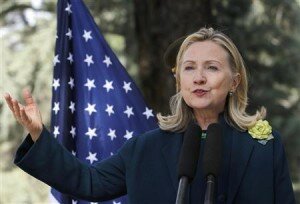Clarity Through Fog Of War
Posted on 26. Oct, 2011 by S M Hali in Pak-US Relations
Our fly on the wall reveals that the US has agreed to our view point but the US will have to abandon its three pre-conditions and turn them into end conditions. Its insistence that the Taliban should denounce Al-Qaeda; lay down arms and spurn violence and accept the US tailored Afghan constitution is unrealistic.
By S. M. Hali

Hillary Rodham Clinton, with her high level entourage in tow, arrived in Islamabad to bring some clarity in the fog of war. CIA Director, General David Petraeus; Chairman US Joint Chiefs of Staff, General Martin Dempsey and US special envoy to Pakistan and Afghanistan, Mark Grossman lent credence to her seriousness in reducing the trust deficit between the erstwhile allies. Hillary Clinton earned the dubious title of behaving like Pakistan’s “Mother-in-Law” and issued warnings to Pakistan to conceptualize its operational plans regarding taking action against the Haqqani network in North Waziristan within days and weeks rather than months or years. She was informed by her Pakistani counterpart that any decisions to that effect will be taken by Pakistan’s parliament.
Three aspects stand out from this particular visit. In her whirlwind style, Secretary Clinton tried to have a free and frank discourse with as many diverse groups as she could in her 48 hours here. She confirmed that the US has no viable proof of the ISI being complicit in the attack on the US Embassy at Kabul last month, thus belying Admiral Mike Mullen’s statement of “the ISI being a veritable arm of the Haqqani Group.” She also confirmed the “Wall Street Journal” story of US officials meeting facilitated by Pakistani intelligence with members of the Haqqani clan. While she hedged questions regarding the stoppage of funds due to Pakistan military, she assured that the US had no intentions of planting “boots on the ground” in Pakistan.
The tone and tenor of the US delegation was tense and somber as the initial statements from Kabul and the body language depicted, however, with each meeting, the ice appeared to melt. What transpired behind closed doors is anybody’s guess but sources privy to the diplomatic parleys indicate that for once the Pakistani delegation comprising the Foreign & Finance Ministers, the Army & ISI Chiefs were in unison and minced no words in expressing their concerns to their US counterparts. The sources indicate that Pakistan welcomed the process of reconciliation but has articulated strong reservations on various aspects. The sources on condition of anonymity expressed that the issue of operationalization needs more coordination. Pakistan has agreed to facilitate US but we need to ponder on how to operationalize? The US has to make some definite decisions and these too in days and weeks rather than months. Firstly it must decide on the process of reconciliation; determine who will do what; what will be the sequence for reconciliation? Pakistan has made it crystal clear that the US must not insist on unrealistic timelines on achieving results or guarantee that the outcome of reconciliation efforts will be positive.
Our fly on the wall reveals that the US has agreed to our view point but the US will have to abandon its three pre-conditions and turn them into end conditions. Its insistence that the Taliban should denounce Al-Qaeda; lay down arms and spurn violence and accept the US tailored Afghan constitution is unrealistic. Pakistan is aware of the Afghan culture and sensitivities to which the US administration appears to be oblivious to. Arms are part of the personal attire of an Afghan, like the baseball cap is to an American. Additionally, any constitution cobbled for the Afghans by the US will remain unacceptable to the Taliban. They will support only a constitution, whose formulation has been contributed by them and not forced on them.
General Petraeus has been advocating hitting the Taliban hard by use of force and compelling them to approach the negotiation table. This strategy is flawed. To start with the NATO, ISAF and Afghan forces have been facing the ignominy of defeat in Afghanistan and under the ground realities; political strategy should be in lead not military strategy. US concept of the 400,000 strong Afghan National Army (ANA) is also based on incorrect precepts. The US plan envisages an estimated expense of 6-8 billion dollars annually. The weak and battered Afghan economy will be unable to sustain the outlay. A financially viable plan should be considered, with lesser numbers and lower upkeep cost not exceeding a billion dollars annually. Without an effective and operationally sound ANA, the country will slide back into anarchy and chaos sinking the entire region into deeper morass.
The mist is clearing to some extent but the US should not push Pakistan in a direction it is not likely to take in Afghanistan i.e. forcing Pakistan to crackdown on the Haqqanis but ignoring Mullah Fazlullah in Afghanistan.
loading...




